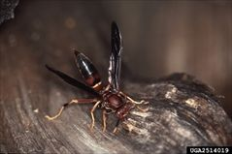Need assistance? Call 800.996.4402
Menu
Need assistance? Call 800.996.4402

Paper wasps get their common name from the paper-like material out of which they make their nests. Paper wasps are sometimes called umbrella wasps, after the shape of their distinctive nests.
Paper wasps are semi-social and live in small colonies. They eat nectar and other insects including caterpillars and flies. In the autumn, inseminated females will seek places to spend the winter, and may find their way indoors, especially if there is a cathedral ceiling present.
While not an aggressive species by nature, paper wasps will sting if they are disturbed or their nest is threatened. Wasp stings are painful and can cause the same risk of allergic reaction as other insect stings.
Paper wasps hang their comb nests from twigs and branches of trees and shrubs, porch ceilings, the tops of window and doorframes, soffits, eaves, attic rafters, deck floor joists and railings, etc.
Paper wasps often build nests in residential yards. Before trimming shrubs or hedges, or picking fruit, check the plant for paper wasp nests. Treat wood fences and deck railings with a repellent oil to deter paper wasps from gathering cellulose from the wood. If you suspect you have a paper wasp infestation or find a wasp nest on your property, contact a licensed pest management professional to find out about wasp treatment. Do not attempt to remove a nest on your own, as there is a high probability you will get stung.






For the very best food safety consulting, auditing and training, please visit our strategic partner, CFS Food Safety